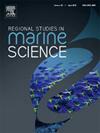Stratigraphic sequences off NE Hainan Island: Controls on sand resource distribution in the South China Sea
IF 2.1
4区 环境科学与生态学
Q3 ECOLOGY
引用次数: 0
Abstract
Sand ridges represent key components of Quaternary transgressive successions. Understanding their sediment routing history is critical for developing predictive models of marine sand resource distribution under rising sea-level scenarios. In the NE Hainan offshore area, while modern sand ridges dominate the seafloor, their sediment provenance and evolutionary trajectory remain poorly constrained, impeding systematic resource exploration. To address this knowledge gap, we integrate high-resolution single-channel seismic profiling with sequence stratigraphic analysis to reconstruct the depositional architecture and sediment routing pathways in this region. Six reflection boundaries and five seismic sequences (SU1-SU5) were distinguished by the abrupt changes in reflection termination patterns, continuity, amplitude variations, and stratal geometry. The stratigraphic record reveals a systematic migration from progradational deltaic facies to transgressive tidal ridges, reflecting a regressive-to-transgressive succession. This evolution is characterized by a complete regressive-transgressive cycle, initiating with forced regression (SU5–SU4) driven by high sediment influx, followed by transgression (SU3–SU1) marked by tidal reworking of antecedent deltaic sands. Such stratigraphic architecture directly controls the distribution of high-quality sandy facies: delta-front sands and tidal-ridge complexes, serving as primary targets for resource exploration. Sequence stratigraphy is shaped by sea-level changes, sediment supply, and hydrodynamics, where SU4 represents the sediment-rich phase while SU2 marks the main sand-ridge construction period. These findings establish a predictive model for marine sand resource exploration by integrating stratigraphic architecture analysis with paleoenvironmental reconstructions to reduce assessment uncertainties.
海南岛东北缘地层层序:对南海砂资源分布的控制
砂脊是第四纪海侵演替的关键组成部分。了解它们的沉积物路线历史对于建立海平面上升情景下海洋砂资源分布的预测模型至关重要。在海南东北部近海地区,现代砂脊在海底占主导地位,但其沉积物物源和演化轨迹仍不明确,阻碍了系统的资源勘探。为了解决这一知识缺口,我们将高分辨率单通道地震剖面与层序地层分析相结合,重建了该地区的沉积构型和沉积路径。根据反射终止模式、连续性、振幅变化和地层几何形状的突变特征,区分出6个反射边界和5个地震序列(SU1-SU5)。地层记录显示了从前积三角洲相到海侵潮脊的系统迁移,反映了退-海侵演替。该演化具有完整的退-海侵旋回的特征,起始于高沉积物流入驱动的强迫退(SU5-SU4),随后是以前代三角洲砂潮改造为标志的海侵(SU3-SU1)。这种地层构型直接控制了优质砂相三角洲前缘砂和潮脊杂岩的分布,是资源勘探的主要目标。层序地层学受海平面变化、沉积物供给和水动力等因素的影响,其中SU4期为富沉积期,SU2期为主要砂岭建设期。通过地层构型分析和古环境重建相结合,降低了评价的不确定性,建立了海相砂资源勘探的预测模型。
本文章由计算机程序翻译,如有差异,请以英文原文为准。
求助全文
约1分钟内获得全文
求助全文
来源期刊

Regional Studies in Marine Science
Agricultural and Biological Sciences-Ecology, Evolution, Behavior and Systematics
CiteScore
3.90
自引率
4.80%
发文量
336
审稿时长
69 days
期刊介绍:
REGIONAL STUDIES IN MARINE SCIENCE will publish scientifically sound papers on regional aspects of maritime and marine resources in estuaries, coastal zones, continental shelf, the seas and oceans.
 求助内容:
求助内容: 应助结果提醒方式:
应助结果提醒方式:


